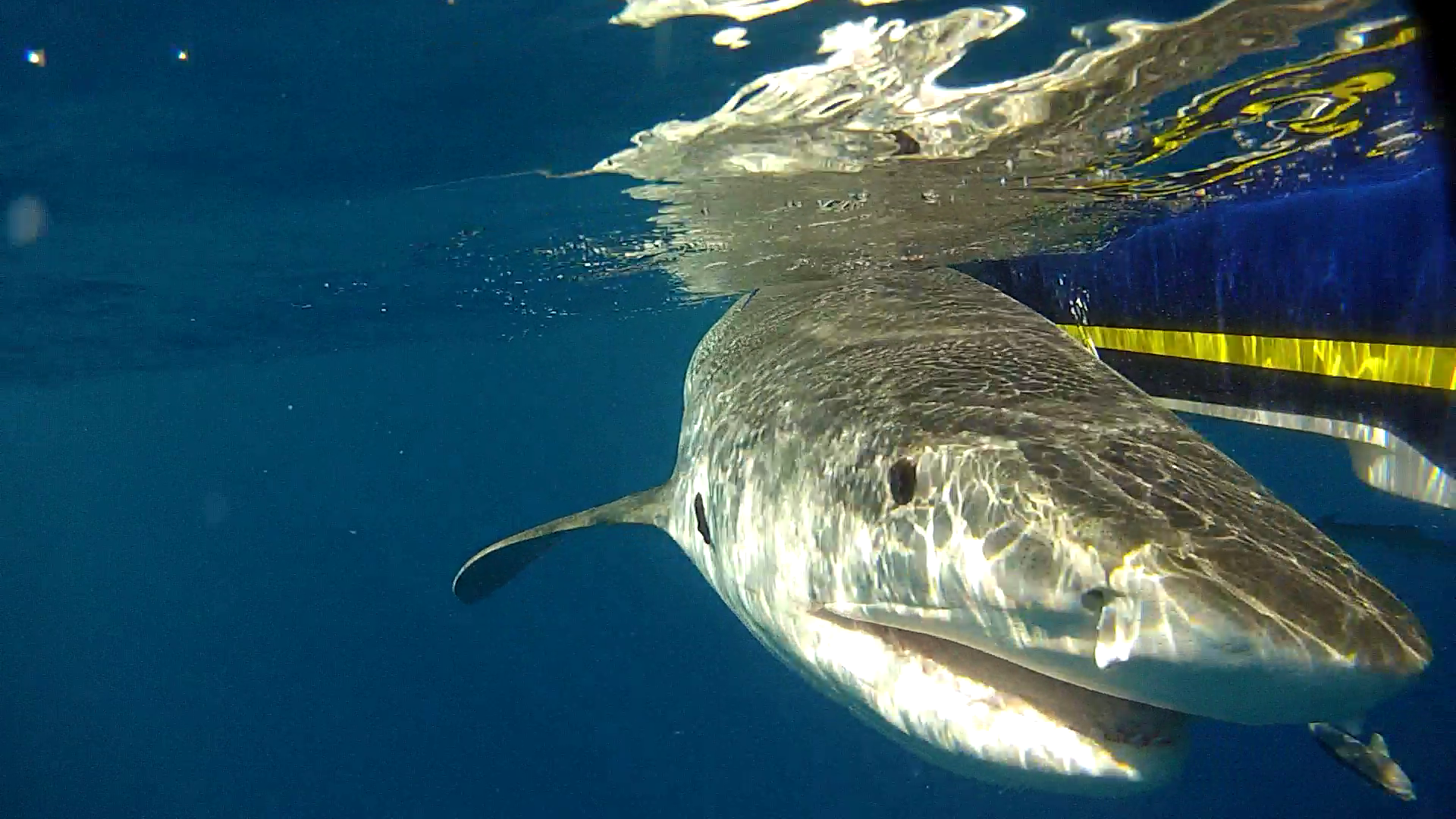HRI's Sportfish Center and OCEARCH to Unlock the Mysteries of Gulf Sharks
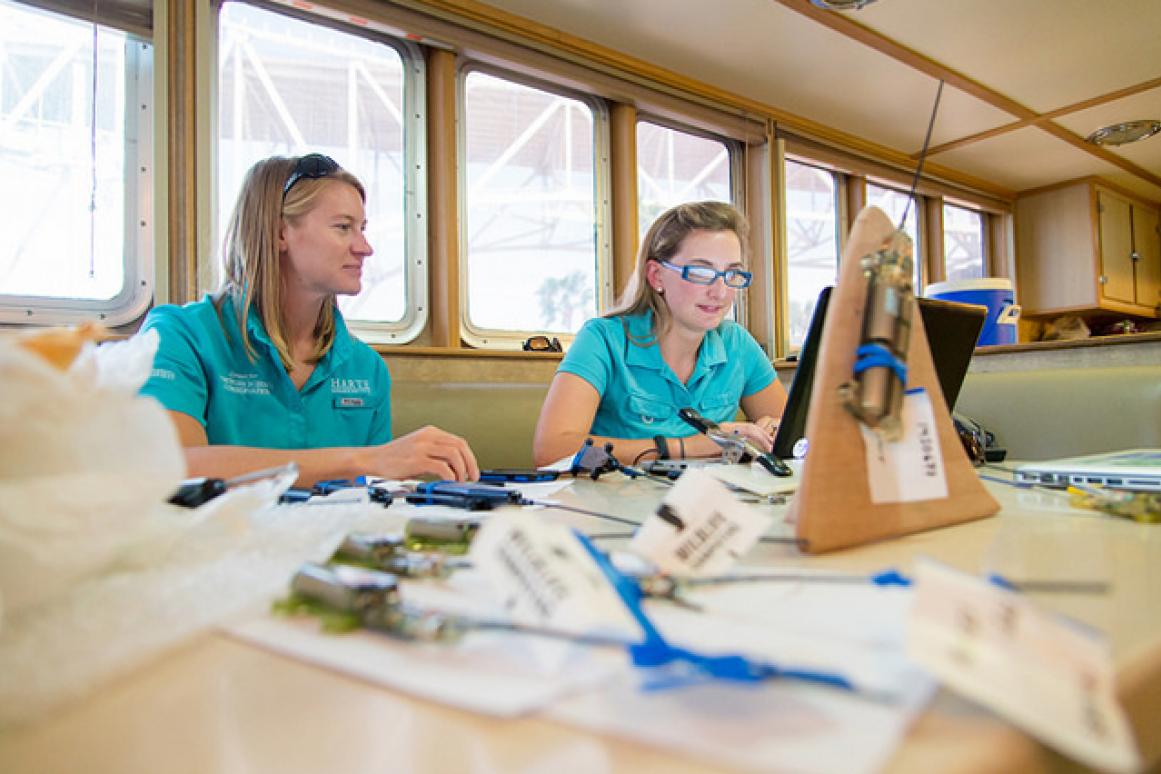
To unlock the secrets of the Gulf of Mexico’s largest and most charismatic apex predators, the Harte Research Institute (HRI) for Gulf of Mexico Studies is teaming up with leading shark-tracking nonprofit OCEARCH for one of the largest tagging expeditions in the region’s history.
HRI Endowed Chair for Fisheries and Ocean Health and Center for Sportfish Science and Conservation (CSSC) Director Dr. Greg Stunz, Assistant Research Scientist Dr. Matt Ajemian and Research Technician Tara Topping will join the OCEARCH expedition, leading a team of scientists from across the Gulf of Mexico. With the help of the uniquely outfitted research vessel the M/V OCEARCH, scientists hope to wrangle some of the Gulf’s great predators, including Tiger, Mako and Hammerhead sharks, for a rare opportunity to handle and study these powerful animals up close.
As top predators in the food chain, sharks help to keep ecosystems healthy. In the Gulf of Mexico, declines of both oceanic and coastal sharks have been reported.
“We are concerned about all fish that make of the marine ecosystem, but probably none is more important than these apex predator,” Stunz said. “They heavily influence the marine ecosystem. Worldwide, their population numbers are in dramatic declines, so it’s important to learn more about their populations and movement for their own sustainability, but also for general ocean health.”
ONBOARD THE OCEARCH
The OCEARCH is a unique vessel designed for the specific task of researching the world’s largest sharks, and has travelled the world tagging white sharks in locations like South Africa, Australia and Cape Cod. This is its first expedition tagging large Gulf of Mexico sharks.

What makes the OCEARCH unique is its lift system. Specifically designed to safely raise large sharks from the water, the lift — which works almost like a shark elevator attached to the side of the OCEARCH vessel — gives researchers unprecedented access to these fascinating animals. Researchers have a limited amount of time, about 20 minutes, to safely handle the shark before returning it to the water and must work almost as a science pit crew, rapidly and carefully drawing blood, tagging the animal, attaching instrumentation like accelerometers and performing an ultrasound on female sharks.

“Our principle goal is to tag and study their migration patterns using sophisticated satellite tags that track real-time movement,” Stunz said. “However, we will also be doing reproduction studies, stress, genetics, and outfit them with cameras for behavioral studies. All of these data will flow back to promoting conservation and sustainability of shark population in the Gulf and worldwide.”
TAGGING SHARKS
The CSSC has tagged thousands of Gulf of Mexico sharks to help better understand their movements, most through a passive tagging program conducted with participating fishermen. The tags are cheap at about $1 apiece, but this method captures only a limited amount of information about the shark’s life in the Gulf. Scientists only know where the shark was re-captured, often a rare event, and where it was released.
Satellite tagging and tracking, by contrast, provides a dynamic picture of the shark’s movements, sending a signal each time the tagged fin breaks the water’s surface. This provides swift and accurate information about the shark’s current location, which is uploaded to a digital map so members of the public as well as scientists can follow the shark’s movements online. So far the CSSC has only been able to tag a limited number of sharks with satellite tags due to the expense and complexity of tagging these large animals.

“This OCEARCH expedition is an essential extension of the work we’re already doing,” Ajemian said. “Right now we have a picture of what these tagged sharks are doing, but it’s based on just a few individuals. We want to replicate that as much as possible, to see if the behavioral patterns that we have seen in our limited data really do apply on a larger scale.”
During the expedition, researchers hope to tag more than 20 large sharks with satellite tags that can record their movement through Gulf waters in real time. Shark species that may not as surface as often, like bull sharks or sandbar sharks, can also be outfitted with acoustic transmitters that regularly send out sound signals, Ajemian said. With the help of a network of “listening” receivers placed in coastal inlets and on oil and gas platforms, scientists can track the sharks’ movement patterns over multiple years.
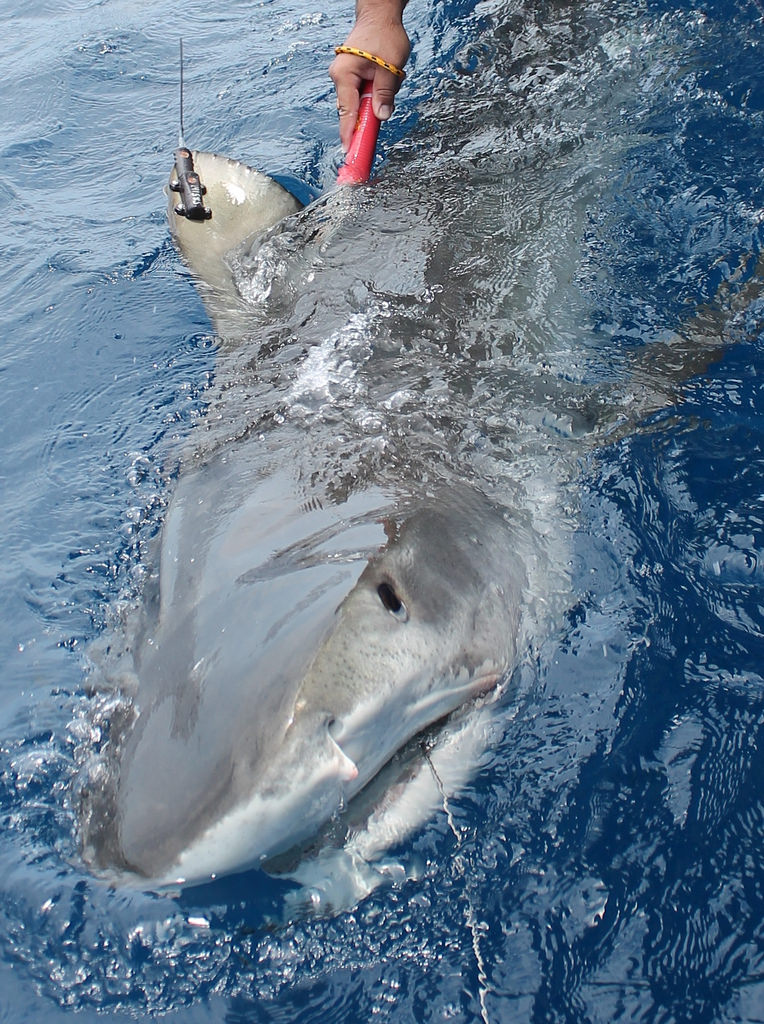
Researchers are discovering a continuum of behaviors through acoustic and satellite tracking of these animals, Ajemian said, with some acting as migrants within a population, and some as residents. Getting a handle on these behaviors and knowing where sharks are going at a given time is important for long-term management of these species.
OTHER RESEARCH
The CSSC is also interested in exploring how sharks are using the Gulf’s artificial reefs versus its natural reefs. Oil and gas development has led to the construction of more than 3,000 oil and gas platforms in northwestern Gulf of Mexico, one of the largest artificial reef systems in the world. These manmade reefs attract diverse communities of marine life, including sharks.
For the last three years, the CSSC has partnered with the Texas Parks and Wildlife Department (TPWD) to conduct the first-ever large-scale monitoring program of life on Texas’ artificial reefs through both dive and ROV (remotely operated vehicle) surveys. After years of observation, scientists have noticed that artificial reefs seem to aggregate marine species in a way that traditional reefs don’t. They’ve also noticed that sharks seem to return to these reefs again and again, using the structures as stepping stones to migrate through the Gulf — a phenomenon known as connectivity.
Sharks are a highly mobile species, sometimes traveling hundreds of miles in a day. That gives them a lot of choice in what habitats they use for hunting, reproducing and raising offspring, Ajemian said.
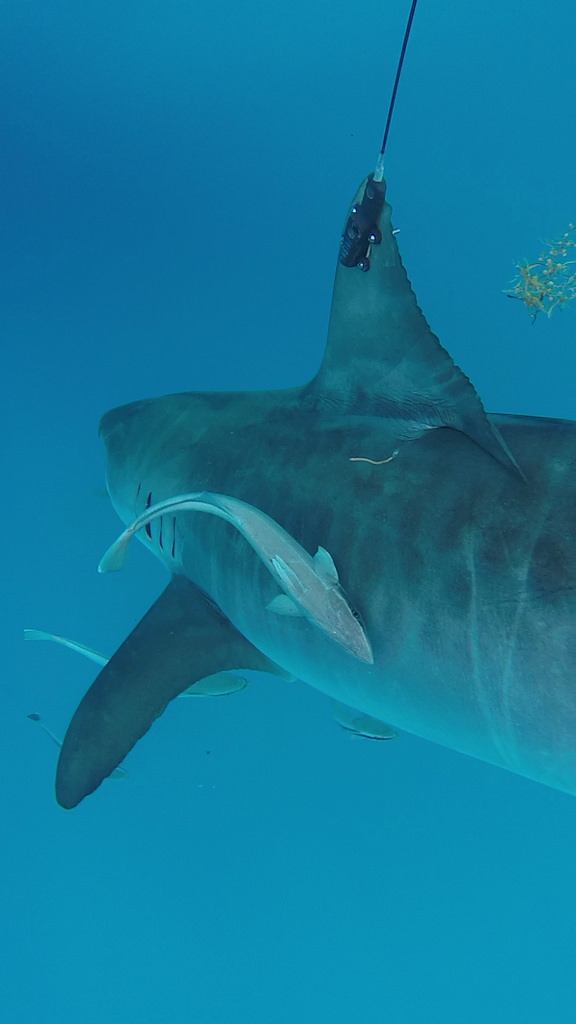
“We’re really interested in how those animals orient to the structures, and whether they stay very long,” Ajemian said. “This will be particularly useful to management of shark populations as these ‘reefings’ of oil and gas platforms are supposed to increase over time.”
Researchers will also draw blood from the animal twice: Once, immediately after the shark is landed and again after the shark is placed in OCEARCH’s unique lift. This will allow scientists to measure the stress level of the shark so that they can determine the best way to handle these important animals. Scientists will run tests for hormone levels to determine how reproductively active the shark has been, and analyze the stable isotope ratio, a test that allows scientists to chemically trace where the animals are feeding in the food chain. Scientists will also perform an ultrasound on the female sharks to determine their reproductive capability.
SAVING SHARKS
Working with sharks is extremely rewarding but can also be frustrating, Ajemian said. Because they’re at the top of the Gulf food chain, they’re naturally rare and difficult to catch. But when researchers do engage them, they fish using a hand line technique that involves tiring out the shark, an exciting fight that puts scientists in close proximity to the power that has made these animals fascinating to people for generations.
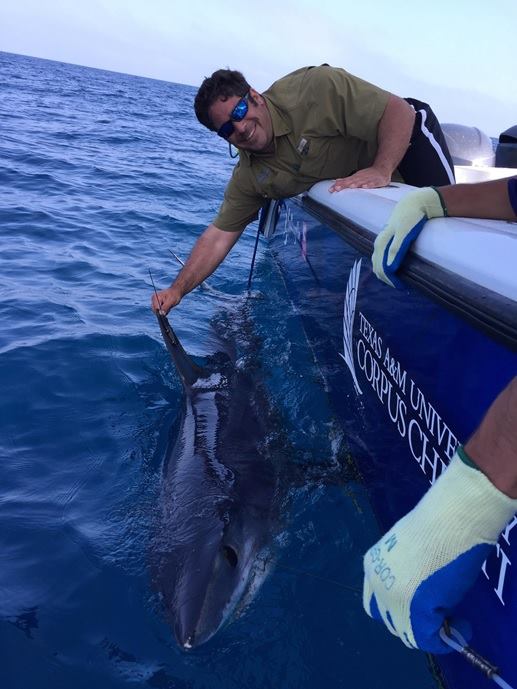
“It’s amazing to see them in their natural habitat, up close and in person. You a sense of how strong and beautiful these animals really are,” Topping said. “You gain an appreciation of why these animals have been around so long, and why they should continue to be around.”
WANT TO KNOW MORE?
Anyone and everyone can follow the OCEARCH expedition by accessing the near-real time, free online Global Shark Tracker or by downloading the Global Shark Tracker App available for Apple and Android platforms. You can also follow the Sportfish Center team on Facebook or Twitter or at #ExpeditionGoMex.
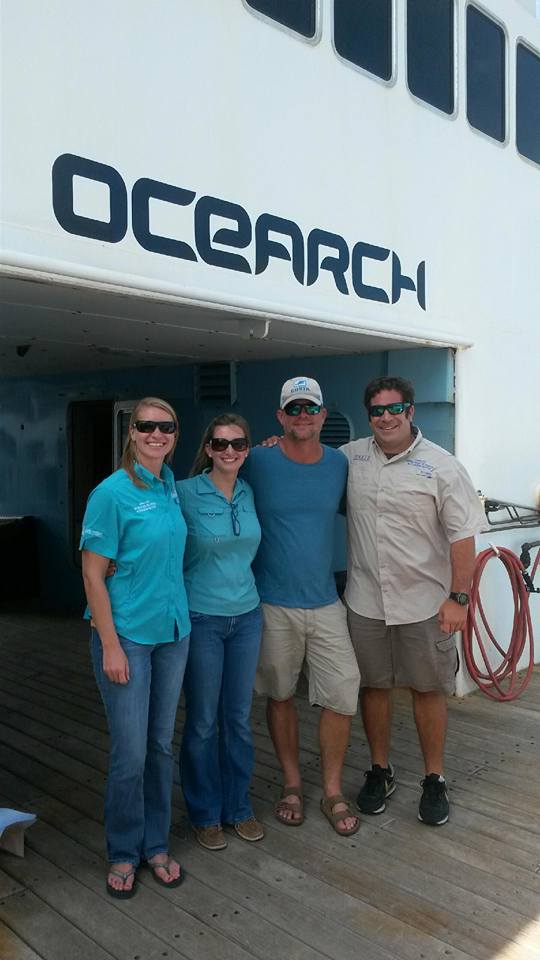
The Texas State Aquarium opened a new exhibit this October featuring the shark tracking research conducted by the CSSC and OCEARCH.
Visit “Saving Sharks: Where Science and Sharks Meet” to learn more.
